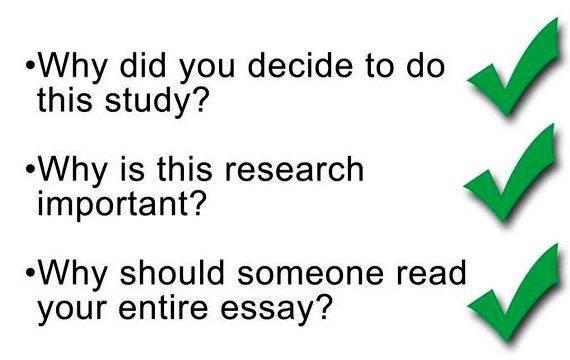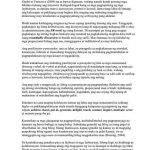An abstract is a short, objective description of an intellectual resource, usually a written document. Professors often assign students to write abstracts to accompany their papers.
When writing an abstract, it is important to keep in mind the purposes of an abstract. One main purpose is to provide readers with useful information about a document. Another main purpose of an abstract is to help readers to evaluate and select a document that they would find useful in their own research. An abstract should allow a reader to get the bare-bones information about a document without requiring them to read the actual document.
An abstract is NOT, however, a simple summary of a document; neither is it a critique of a document.
Writing the Abstract
Because an abstract is a description of an entire document, you can write an abstract only for a document that is complete. If you are writing an abstract as part of a class paper, you need to finish your paper before you start working on your abstract.
Keep in mind the ABCs of a good abstract:
- Accuracy a good abstract includes only information included in the original document
- Brevity a good abstract gets straight to the point, contains precise language, and does not include superfluous adjectives
- Clarity a good abstract does not contain jargon or colloquialisms and always explains any acronyms
Several writing guidelines can make writing a good abstract easier:
- Do not refer to the author (e.g. “Dr. Seuss argues”)
- Do not refer to what type of document you are abstracting (e.g. “This book describes”)
- Use complete sentences
- Use active verbs whenever possible
- Use familiar terminology whenever you can (and always explain terms that may be unfamiliar to the average reader)
The Informative Abstract
One common type of abstract is an informative abstract.
If you are writing an abstract for a strictly-structured document like an experiment, investigation, or survey, you will write an informative abstract.
An informative abstract is made up of four parts:
The purpose section of an informative abstract should state either the reason for or the primary objectives of the experiment or investigation. The purpose section of an informative abstract might also contain the hypothesis of the experiment.
The methodology section of an informative abstract should describe the techniques used in conducting the experiment. This section should give only as much detail as is necessary to understand the experiment; the abstract should not focus entirely on research methods unless that is the primary focus of the original document.
The results section of an informative abstract should relate the observations and/or data collected during the experiment. This section should be concise and informative, and only the most important results need be included.
The conclusion section of an informative abstract should state the evaluation or analysis of the experiment results. It should also briefly state the implications of these results. This conclusion section might also state whether the driving hypothesis of the experiment was correct.
A Sample Informative Abstract:
Subjects’ car clocks were set ten minutes fast in order to determine if deliberately setting a clock ahead will reduce lateness.

One group of subjects knew their clocks had been set ahead, while a second group of subjects was not informed of the change. Over a four-week period, the subjects who were aware of the clock change regularly arrived on time or late for their scheduled appointments. Over the same period of time, the subjects who were unaware of the clock change tended to arrive early or on time for their appointments. Data suggest that intentionally setting a clock to run fast does not reduce lateness because one accounts for that extra time in his or her schedule.
The Indicative Abstract
A second type of abstract is an indicative abstract. If you are writing an abstract for a less-structured document like an essay. editorial. or book. you will write an indicative abstract.
An indicative abstract is generally made up of three parts:
The scope section of an indicative abstract should state the range of the material dealt with in the original document as well as the starting premise of the document. An abstract for an essay on Shakespeare’s comedies, for example, would state that the Bard’s comedies make up the focus of the essay.
The arguments used section of an indicative abstract should state the main arguments and counterarguments employed in the original document. These arguments should be stated in the same progression in which they appear in the document. Not all documents contain a progression of arguments; in some cases this section may outline analysis or plot progression instead.
The conclusions section of an indicative abstract should state the document’s main closing argument and its implications as suggested by the original author. This conclusion section might also state plot resolution when the original document is a work of fiction.
A Sample Indicative Abstract:
Types of female power in Jane Austen’s Pride and Prejudice are discussed. Mrs. Bennet and Charlotte Lucas represent the lack of power possessed by married women of the middle class. Lady Catherine and Caroline Bingley demonstrate the power of wealthy, single women to occasionally flaunt rules of etiquette. Lydia Bennet represents the risks of female power when bestowed upon too immature a woman, but Elizabeth and Jane Bennet characterize the positive personal and social effects of women who recognize their own power over self.
A Few More Tips
If you are writing an abstract about a document not written by you, make sure to include the document’s bibliographic information before your abstract.
Also, because you could write an abstract for documents of any size, there are general guidelines about how long your abstract should be:
- For an editorial or letter to the editor, 30 words or less
- For a short note or short communication, 100 words or less
- For a shorter paper or article, 150-200 words or less
- For a longer paper, article, or book chapter, 250 words or less
- For long documents like a thesis or book, 300 words or less
While these length guidelines can help you as you learn how to write abstracts, with practice you will develop a sense about what lengthand how much descriptionis sufficient for each individual abstract.
Polishing the Abstract
After you’ve completed your abstract, go back over the ABCs of a good abstract and ask yourself a few questions:
- How accurate is my abstract? Is it consistent with the information in the original document?
- How brief is my abstract? Did I substantially reduce the amount of text necessary to convey the main ideas?
- How clear is my abstract? Can a non-specialized reader easily understand all the information?
Also, be sure to proofread your abstract carefully for errors and typos. If you have a bibliographic heading, double-check it for accuracy and correct spelling as well.
Produced by Writing Tutorial Services, Indiana University, Bloomington, IN
wts/shtml_navs/iub.jpg” />
Writing Tutorial Services
Center for Innovative Teaching and Learning
Wells Library Learning Commons, 1320 E. Tenth St. Bloomington, IN 47405
Phone: (812) 855-6738
Comments
What is an Abstract?
- The abstract is an important component of your thesis. Presented at the beginning of the thesis, it is likely the first substantive description of your work read by an external examiner. You should view it as an opportunity to set accurate expectations.
- The abstract is a summary of the whole thesis. It presents all the major elements of your work in a highly condensed form.
- An abstract often functions, together with the thesis title, as a stand-alone text. Abstracts appear, absent the full text of the thesis, in bibliographic indexes such as PsycInfo. They may also be presented in announcements of the thesis examination. Most readers who encounter your abstract in a bibliographic database or receive an email announcing your research presentation will never retrieve the full text or attend the presentation.
- An abstract is not merely an introduction in the sense of a preface, preamble, or advance organizer that prepares the reader for the thesis. In addition to that function, it must be capable of substituting for the whole thesis when there is insufficient time and space for the full text.
Size and Structure
- Currently, the maximum sizes for abstracts submitted to Canada’s National Archive are 150 words (Masters thesis) and 350 words (Doctoral dissertation).
- To preserve visual coherence, you may wish to limit the abstract for your doctoral dissertation to one double-spaced page, about 280 words.
- The structure of the abstract should mirror the structure of the whole thesis, and should represent all its major elements.
- For example, if your thesis has five chapters (introduction, literature review, methodology, results, conclusion), there should be one or more sentences assigned to summarize each chapter.
- As in the thesis itself, your research questions are critical in ensuring that the abstract is coherent and logically structured. They form the skeleton to which other elements adhere.
- They should be presented near the beginning of the abstract.
- There is only room for one to three questions. If there are more than three major research questions in your thesis, you should consider restructuring them by reducing some to subsidiary status.
Don’t Forget the Results
- The most common error in abstracts is failure to present results.
- The primary function of your thesis (and by extension your abstract) is not to tell readers what you did, it is to tell them what you discovered. Other information, such as the account of your research methods, is needed mainly to back the claims you make about your results.
- Approximately the last half of the abstract should be dedicated to summarizing and interpreting your results.






 Phd thesis writing services in pune
Phd thesis writing services in pune Writing a phd thesis abstract
Writing a phd thesis abstract Pasasalamat sa isang thesis writing
Pasasalamat sa isang thesis writing University of auckland best doctoral thesis or dissertation
University of auckland best doctoral thesis or dissertation Ugc norms for phd thesis writing
Ugc norms for phd thesis writing






